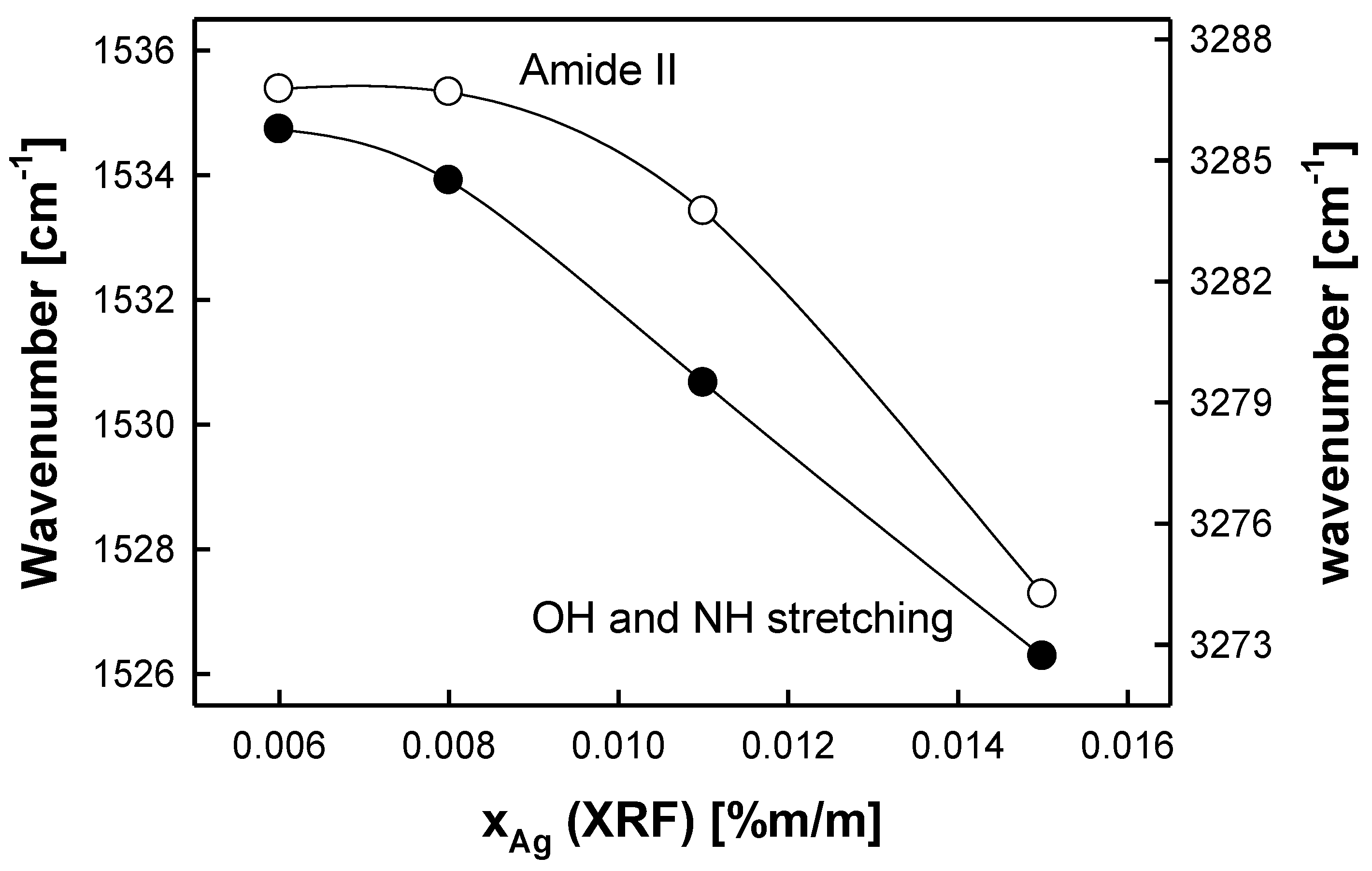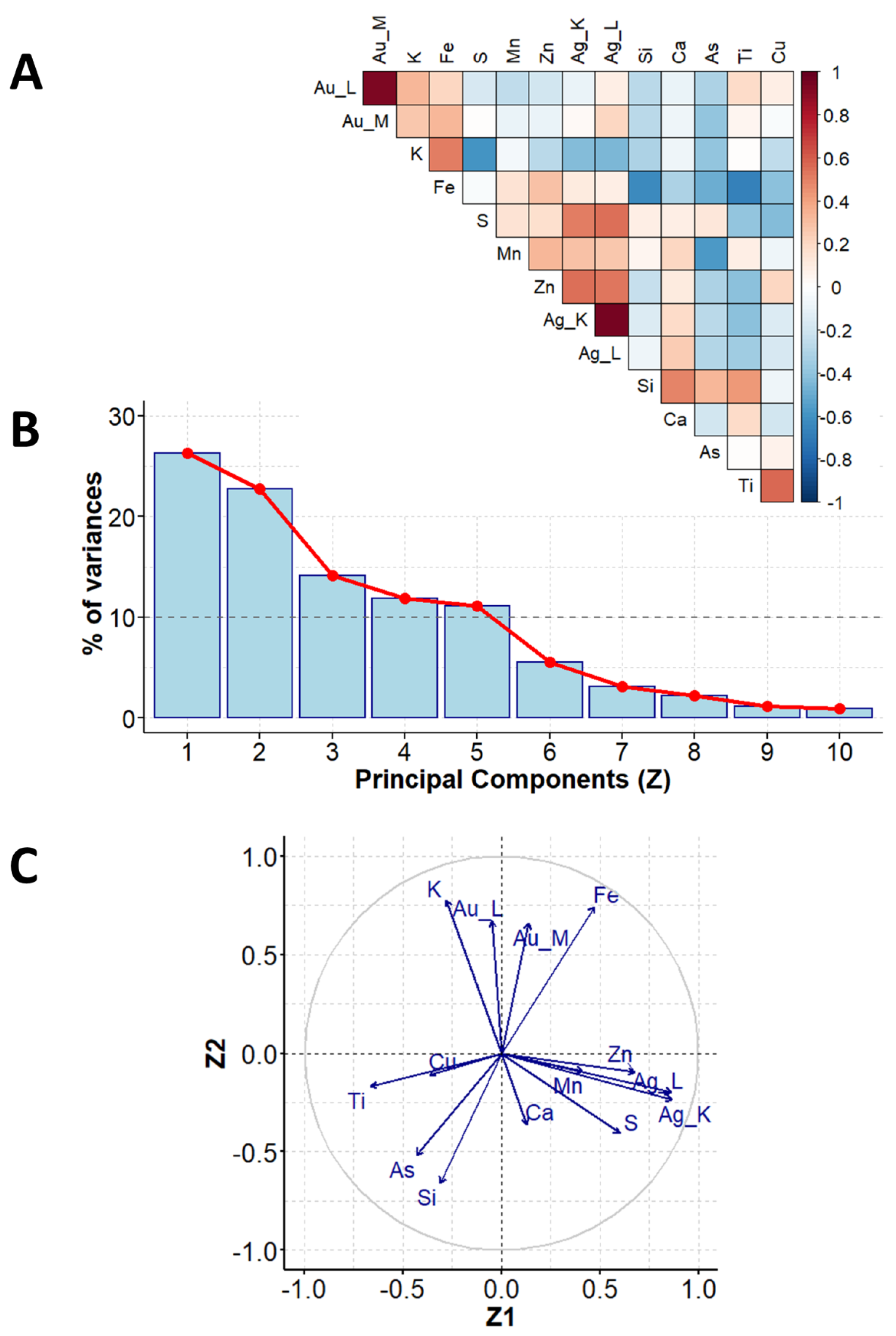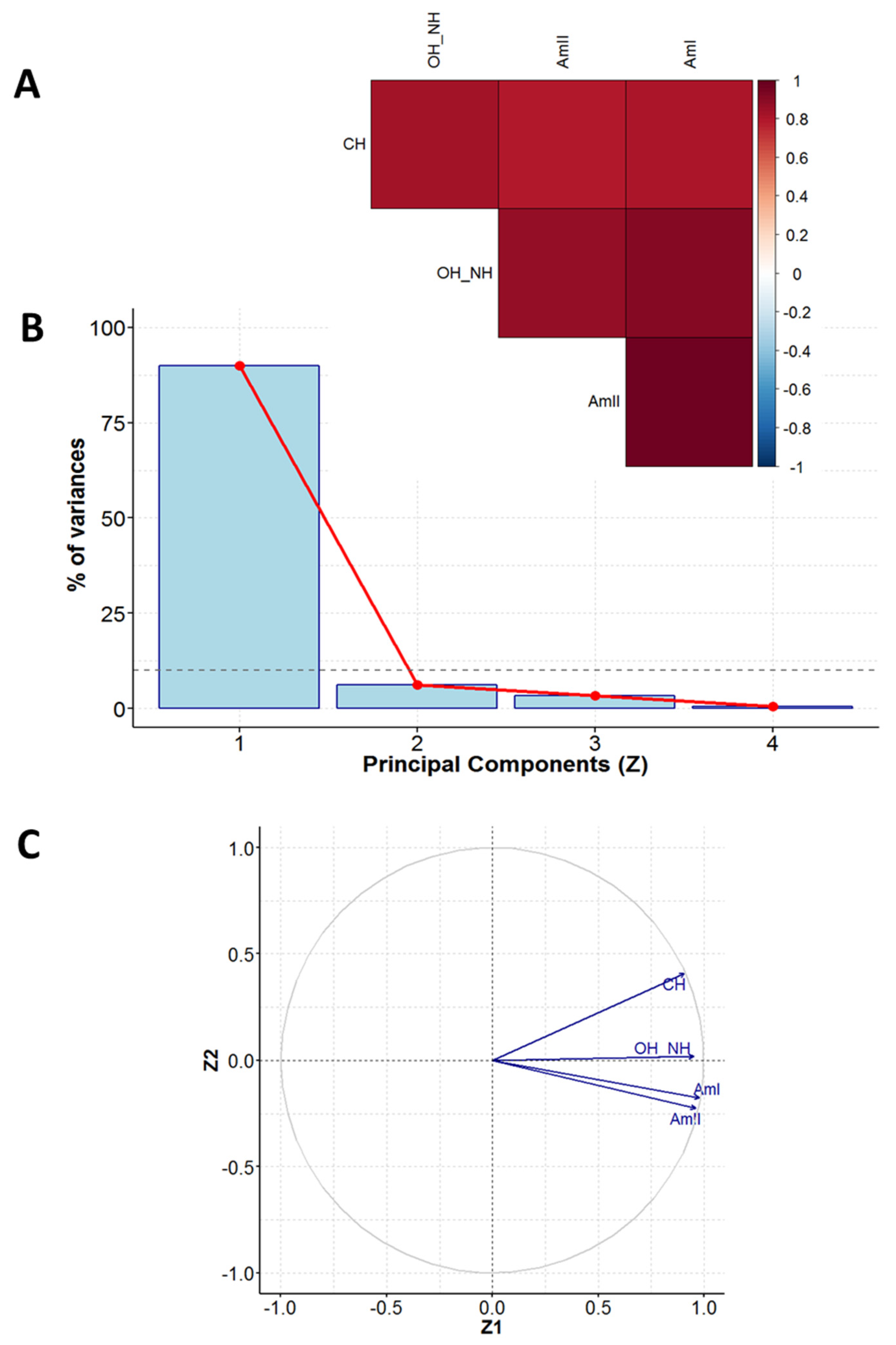Studies on the Authorship of Albumen Vintage Photographs: A Combined Experimental and Chemometric Approach
Abstract
:1. Introduction
2. Results
2.1. Theoretical Basis of Principal Component Analysis (PCA)
- The calculation of arithmetic mean values (xi) and standard deviations (SD(xi)) of individual variables (either metal concentrations or IR wavenumbers, i = 1, …, m, m—the number of variables, with each variable represented by n measurements, n—number of samples/objects).
- Data scaling, especially in the case of the incomparability of initial data, i.e., in the case when the initial variables represent different measured values (measurements in different units) or in the case of large differences in the values of the measured quantity).
- 3.
- The construction of the data matrix X: X = [X1, X2, …, Xm]—matrix size m × n.
- 4.
- The construction of correlation matrix R (matrix formed from correlation coefficients between particular pairs of variables r(Xi, Xk) for i, k = 1, …, m (r(Xi, Xi) = 1). R = [r(X1), r(X2), …, r(Xm)]—matrix size m × m.
- 5.
- Searching for the eigenvalues of the correlation matrix R, i.e., λ1, λ2, …, λm.
- 6.
- Determining the eigenvectors of the correlation matrix R, i.e., v1, v2, …, vm, where the i-th vector can be represented by the following notation.
- 7.
- Determination of the contribution of the variance of the i-th Z component in the total variance based on the eigenvalues of the correlation matrix R.
- 8.
- Selection of the main components based on the analysis of the scree plot. The factor of scree is given by eigenvalues (and consequently Zi components) that have the smallest contribution to the sum of eigenvalues (i.e., those components that, together, explain less than 10–15% of the total variance of the initial variables).
- 9.
- The determination of correlation coefficients between variables and their main components (the correlation coefficient between the vector of the main component Z and the vector of variable Xi, r(Z, Xi)).These calculations are illustrated by a pie chart of variables in the coordination system of the main components. Correlation coefficients act as the coordinates of points representing particular variables in the main component graph. The length of the variable vector represents the strength of the correlation and its direction—the sign of the correlation coefficient.
- 10.
- The calculation of determination coefficients (squares of correlation coefficients between variables and main components). The values of determination coefficients determine the degree of representation of a given component by particular variables quantitatively.
- 11.
- The graphical location of individual objects in the coordinate system of main components (usually Z1 and Z2). The coordinates of a given object (z1, z2) are determined from the expressions of the Z1 and Z2 components (obtained in point 6.). The calculations are illustrated by a graph in the coordinate system of the main components.
2.2. The Characterization of Reference Albumen Photo Samples
2.2.1. The Effect of the AgNO3 Concentration and UV Illumination Time on the Content of Silver Particles Determined in the Photo Samples
2.2.2. The Effect of the AgNO3 Concentration and UV Illumination Time on the Position of the Characteristic IR Signals of Albumen Layers
2.3. Chemometric Analysis of XRF Determinations for Vintage Photographs
- A diagram of correlation coefficients for all unique pairs of variables (Figure 3A, step 4 in Section 2.1);
- The scree plot representing the contributions of individual components to the total variance (Figure 3B, step 7 in Section 2.1);
- A pie chart demonstrating the correlation between the main components no. 1 and 2 (Z1 and Z2) and variables (Figure 3C, step 9 in Section 2.1);
- A plot of the locations of individual objects in the coordination systems defined by the main components no. 1 and 2 (Z1 and Z2) and no. 2 and 3 (Z2 and Z3) (Figure 4a,b, step 11 in Section 2.1); these coordinates are the scores returned by the PCA analysis.
2.4. Chemometric Analysis of FTIR Measurements for Vintage Photographs
- A diagram of correlation coefficients for all unique pairs of variables (Figure 5A);
- The scree plot representing the contributions of individual components to the total variance (Figure 5B);
- A pie chart of the correlation between the main components no. 1 and 2 (Z1 and Z2) and variables (Figure 5C);
- A plot of the locations of individual objects in the coordination system defined by the main components no. 1 and 2 (Z1 and Z2) (Figure 6); these coordinates are the scores returned by the PCA analysis.
3. Discussion
3.1. XRF Measurements
3.2. FTIR Measurements
4. Materials and Methods
4.1. Preparation of the Reference Photo Samples
4.1.1. Chemicals
4.1.2. Experimental Procedure
4.2. Instrumental Techniques
4.3. Objects—Albumen Vintage Photographs
- Karol Beyer “Views of Warsaw” (“Widoki Warszawy”), [MW AF 9773], (PPA 1);
- Karol Beyer “Views of Warsaw” (“Widoki Warszawy”), [MNW DI 105371 (1–24)], second copy-other edition, (PPA 2);
- Konrad Brandel “Views of Warsaw” (“Widoki Warszawy”), [MW AL 78], edition in brown canvas, (PPA 3);
- Konrad Brandel “Views of Warsaw” (“Widoki Warszawy”), [MW AL. 79], edition in red canvas, (PPA 4);
- Album, [MHK Fs 4452/IX/31], (CFPA 1);
- Album, [AGAD,Division III, nr IX], (CFPA 2);
- Album, [AGAD, Division III, nr V], (CFPA 3).
5. Conclusions
Supplementary Materials
Author Contributions
Funding
Institutional Review Board Statement
Informed Consent Statement
Data Availability Statement
Conflicts of Interest
References
- Le Gray, G. A Practical Treatise on Photography, upon Paper and Glass; T. & R. Willats: London, UK, 1850. [Google Scholar]
- Towler, J. The Silver Sunbeam; E. & H.T. Anthony & Co.: New York, NY, USA, 1864. [Google Scholar]
- Haist, G.M. Modern Photographic Processing, 1st ed.; Wiley Series on Photographic Science & Technology & the Graphic Arts; John Wiley & Sons Inc.: New York, NY, USA, 1979; Volume 1. [Google Scholar]
- Messier, P. Protein Chemistry of Albumen Photographs. Top. Photogr. Preserv. 1991, 4, 124–135. [Google Scholar]
- Reilly, J.M. The Manufacture and Use of Albumen Paper. J. Photogr. Sci. 1978, 26, 156–161. [Google Scholar] [CrossRef]
- Reilly, J.M. Role of Maillard, or “Protein-Sugar” Reaction in Highlight Yellowing of Albumen Photographic Prints. In Proceedings of the Preprints of Papers Presented at the Tenth Annual Meeting Milwaukee, Milwaukee, WI, USA, 26–30 May 1982; The American Institute for Conservation of Historic and Artistic Works: Washington, DC, USA, 1982; pp. 160–168. [Google Scholar]
- Reilly, J.M.; Kennedy, N.; Black, D.; Van Dam, T. Image Structure and deterioration in Albumen Prints. Photogr. Sci. Eng. 1984, 28, 166–171. [Google Scholar]
- Messier, P.; Vitale, T. Effects of Aqueous Treatment on Albumen Photographs. J. Am. Inst. Conserv. 1994, 33, 257–299. [Google Scholar] [CrossRef]
- Ricci, C.; Bloxham, S.; Kazarian, S.G. ATR-FTIR imaging of albumen photographic prints. J. Cult. Herit. 2007, 8, 387–395. [Google Scholar] [CrossRef]
- Centeno, S.A.; Vila, A.; Barro, L. Characterization of unprocessed historic platinum photographic papers by Raman, FTIR and XRF. Microchem. J. 2014, 114, 8–15. [Google Scholar] [CrossRef]
- Rampazzi, L.; Brunello, V.; Campione, F.P.; Corti, C.; Geminiani, L.; Recchia, S.; Luraschi, M. Non-invasive identification of pigments in Japanese coloured photographs. Microchem. J. 2020, 157, 105017. [Google Scholar] [CrossRef]
- Modica, A.; Alberghina, M.F.; Brai, M.; Bruno, M.; Di Bella, M.; Fontana, D.; Tranchina, L. XRF analysis to identify historical photographic processes: The case of some Interguglielmi Jr.’s images from the Palermo Municipal Archive. Radiat. Phys. Chem. 2017, 135, 76–80. [Google Scholar] [CrossRef]
- Puškárová, A.; Bučková, M.; Habalová, B.; Kraková, L.; Maková, A.; Pangallo, D. Microbial communities affecting albumen photography heritage: A methodological survey. Sci. Rep. 2016, 6, 20810. [Google Scholar] [CrossRef]
- Daher, C.; Languille, M.-A.; de Mondenard, A.; Becka, M.; Garnier, C.; Tournie, A.; Aubenas, S.; Lavedrine, B. Spectroscopic characterization of selected French paper negatives (1843–1856): How to see through many processes? Microchem. J. 2019, 149, 104069. [Google Scholar] [CrossRef]
- Szökefalvi-Nagy, Z.; Demeter, I.; Kocsonya, A.; Kovács, I. Non-destructive XRF analysis of paintings. Nucl. Instrum. Methods Phys. Res. Sect. B Beam Interact. Mater. At. 2004, 226, 53–59. [Google Scholar] [CrossRef]
- Janssens, K.; Vittiglio, G.; Deraedt, I.; Aerts, A.; Vekemans, B.; Vincze, L.; Wei, F.; De Ryck, I.; Schalm, O.; Adams, F.; et al. Use of microscopic XRF for non-destructive analysis in art and archaeometry. X-ray Spectrom. 2000, 29, 73–91. [Google Scholar] [CrossRef]
- Janssens, K.; Van der Snickt, G.; Vanmeert, F.; Legrand, S.; Nuyts, G.; Alfeld, M.; Monico, L.; Anaf, W.; De Nolf, W.; Vermeulen, M.; et al. Non-Invasive and Non-Destructive Examination of Artistic Pigments, Paints, and Paintings by Means of X-ray Methods. Top. Curr. Chem. 2016, 374, 81. [Google Scholar] [CrossRef]
- Vila, A.; Centeno, S.A. FTIR, Raman and XRF identification of the image materials in turn of the 20th century pigment-based photographs. Microchem. J. 2013, 106, 255–262. [Google Scholar] [CrossRef]
- Gerodimos, T.; Asvestas, A.; Mastrotheodoros, G.P.; Chantas, G.; Liougos, I.; Likas, A.; Anagnostopoulos, D.F. Scanning X-ray Fluorescence Data Analysis for the Identification of Byzantine Icons’ Materials, Techniques, and State of Preservation: A Case Study. J. Imaging 2022, 8, 147. [Google Scholar] [CrossRef]
- Zamboni, C.B.; Redígolo, M.M.; Miura, T.V.; Costa, I.; Nagai, M.L.E.; Salvador, P.A.V.; da Silva, D.G.N. Non-destructive analysis in the study of historical photographs by pXRF and ATR-FTIR spectroscopies. J. Forensic Sci. 2021, 66, 1048–1055. [Google Scholar] [CrossRef]
- Neiva, A.C.; Marcondes, M.A.; Pinto, H.P.F.; Almeida, P.A.D. Analysis of photographs and photo-paintings by energy-dispersive X-ray fluorescence spectroscopy. Radiat. Phys. Chem. 2014, 95, 378–380. [Google Scholar] [CrossRef]
- Xia, J.; Zhang, J.; Zhao, Y.; Huang, Y.; Xiong, Y.; Min, S. Fourier transform infrared spectroscopy and chemometrics for the discrimination of paper relic types. Spectrochim. Acta Part A Mol. Biomol. Spectrosc. 2019, 219, 8–14. [Google Scholar] [CrossRef]
- Oravec, M.; Haberová, K.; Jančovičová, V.; Machatová, Z.; Ceppan, M.; Huck, C.W. Identification of the historic photographic print materials using portable NIR and PCA. Microchem. J. 2019, 150, 104202. [Google Scholar] [CrossRef]
- Mantler, M.; Klikovits, J. Analysis of art objects and other delicate samples: Is XRF really nondestructive? Powder Diffr. 2004, 19, 16–19. [Google Scholar] [CrossRef]
- Borgwardt, T.C.; Wells, D.P. What does non-destructive analysis mean? Cogent Chem. 2017, 3, 1405767. [Google Scholar] [CrossRef]
- Doherty, B.; Vagnini, M.; Dufourmantelle, K.; Sgamellotti, A.; Brunetti, B.; Miliani, C. A vibrational spectroscopic and principal component analysis of triarylmethane dyes by comparative laboratory and portable instrumentation. Spectrochim. Acta Part A Mol. Biomol. Spectrosc. 2014, 121, 292–305. [Google Scholar] [CrossRef] [PubMed]
- Weintraub, M. Beyer, Karol Adolf (1818–1877). In Encyclopedia of Nineteenth-Century Photography; Hannavy, J., Ed.; Routledge: New York, NY, USA; London, UK, 2008; Volume 1, p. 154. [Google Scholar]
- Miller, J.N.; Miller, J.C. Statistics and Chemometrics for Analytical Chemistry, 5th ed.; Prentice Hall: London, UK, 2005. [Google Scholar]
- Zając, I. A new typology of nineteenth century photograph albums. In Between Science and Art; Ciechańska, M., Ed.; Akademia Sztuk Pięknych: Warsaw, Poland, 2016; pp. 297–314. [Google Scholar]






| Chemical | Purity | Manufacturer | Role |
|---|---|---|---|
| Silver nitrate (AgNO3) | 99.9% | Honeywell, Tokyo, Japan | Silver ions source, photosensitive medium |
| Sodium thiosulfate pentahydrate (Na2S2O3·5H2O) | 99.5% | Sigma Aldrich, St. Louis, MI, USA | Complexing agent |
| Citric acid monohydrate (C6H8O7·H2O) | >99% | POCh Gliwice, Gliwice, Poland | Reducing agent |
| Ammonium chloride (NH4Cl) | >99% | POCh Gliwice, Gliwice, Poland | Precipitating agent |
| Aluminum potassium sulfate dodecahydrate pure (AlK(SO4)2·12H2O) | >99% | WarChem Sp.z.o.o., Zakręt, Poland | Antibacterial agent |
| Albumen | Unknown | Custom preparation | Base for silver ions |
| Gelatine-covered paper: Bovine gelatin | - | Photogelatine Type Restoration 1, (GMW Germany, Gelita, Eberbach, Germany) | Base for albumen, Photosensitive medium |
| Whatman blotting paper | - | Whatman blotting paper 1 (GE Healthcare Life Sciences WhatmanTM, GE Healthcare UK Limited, Glasgow, UK) | Base for albumen, Photosensitive medium |
| Ultrapure water | 0.055 µS·cm−1 * | Milli-Q system | Solvent, Liquid used for washing process |
Disclaimer/Publisher’s Note: The statements, opinions and data contained in all publications are solely those of the individual author(s) and contributor(s) and not of MDPI and/or the editor(s). MDPI and/or the editor(s) disclaim responsibility for any injury to people or property resulting from any ideas, methods, instructions or products referred to in the content. |
© 2024 by the authors. Licensee MDPI, Basel, Switzerland. This article is an open access article distributed under the terms and conditions of the Creative Commons Attribution (CC BY) license (https://creativecommons.org/licenses/by/4.0/).
Share and Cite
Adamowska, M.; Zając, I.; Sawicki, M.G.; Hyk, W. Studies on the Authorship of Albumen Vintage Photographs: A Combined Experimental and Chemometric Approach. Molecules 2024, 29, 2170. https://doi.org/10.3390/molecules29102170
Adamowska M, Zając I, Sawicki MG, Hyk W. Studies on the Authorship of Albumen Vintage Photographs: A Combined Experimental and Chemometric Approach. Molecules. 2024; 29(10):2170. https://doi.org/10.3390/molecules29102170
Chicago/Turabian StyleAdamowska, Monika, Izabela Zając, Marek Grzegorz Sawicki, and Wojciech Hyk. 2024. "Studies on the Authorship of Albumen Vintage Photographs: A Combined Experimental and Chemometric Approach" Molecules 29, no. 10: 2170. https://doi.org/10.3390/molecules29102170






